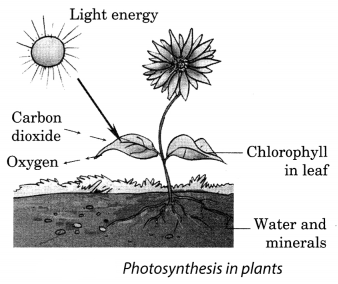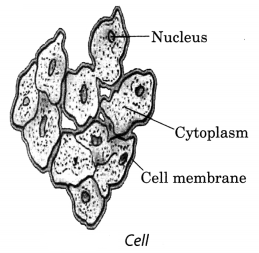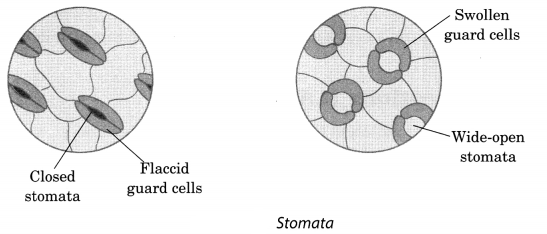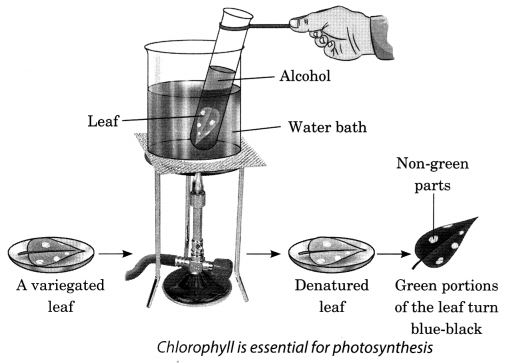In this page, we are providing Nutrition in Plants Class 7 Extra Questions and Answers Science Chapter 1 pdf download. NCERT Extra Questions for Class 7 Science Chapter 1 Nutrition in Plants with Answers will help to score more marks in your CBSE Board Exams.
Class 7 Science Chapter 1 Extra Questions and Answers Nutrition in Plants
Extra Questions for Class 7 Science Chapter 1 Nutrition in Plants with Answers Solutions
Extra Questions for Class 7 Science Chapter 1 Very Short Answer Type
Question 1.
Name the components of food.
Answer:
Carbohydrates, fats, proteins, vitamins, and minerals.
Question 2.
What are stomata?
Answer:
Tiny pores on the leaves are known as stomata.
Question 3.
Name the pigment which makes leaves green.
Answer:
Chlorophyll
Question 4.
State the function of chlorophyll.
Answer:
It captures energy of sunlight.
Question 5.
Name the unit which makes the bodies of living organisms.
Answer:
Cell
Question 6.
Give an example of an insectivorous plant.
Answer:
Sundew plant
Question 7.
What is the mode of nutrition of Cuscuta?
Answer:
Parasitic
Question 8.
What are the main parts of a cell?
Answer:
- Cell membrane
- Nucleus
- Cytoplasm
Question 9.
Which mode of nutrition is used by green plants?
Answer:
Autotrophic mode
Question 10.
Why insectivorous plants feed on insects?
Answer:
Insectivorous plants feed on insects to fulfill their nitrogen needs.
Question 11.
What are the raw materials for photosynthesis?
Answer:
- Water
- CO2
- Sunlight
- Chlorophyll
Question 12.
What is autotrophic nutrition?
Answer:
The type of nutrition in which organism prepare their own food is known as autotrophic nutrition.
Question 13.
What is photos3mthesis?
Answer:
The process by which green plants prepare their own food using CO2 and water in the presence of sunlight and chlorophyll is called photosynthesis.
Question 14.
What are heterotrophs?
Answer:
The type of organisms which depend on other organisms for their food are known as heterotrophs.
Question 15.
What do you mean by saprophytic nutrition?
Answer:
The type of nutrition in which organisms depend upon dead and decaying matter for their food is known as saprophytic nutrition.
Question 16.
Name two plants that have a symbiotic relationship with Rhizobium bacteria.
Answer:
Peas and moong
Question 17.
What are insectivorous plants? Give an example.
Answer:
The plants which trap insects for feeding are called insectivorous plants. For example, pitcher plant.
Question 18.
What are parasites?
Answer:
The organisms which obtain nutrients from other organisms are called parasites.
Question 19.
What is host?
Answer:
The organisms which provide nutrients to another organism, known as parasites, is called host.
Extra Questions for Class 7 Science Chapter 1 Short Answer Type
Question 1.
What is haustoria?
Answer:
Haustoria is the root of a parasitic plant that penetrates the host’s tissue and draws nutrients from it.
Question 2.
Differentiate between parasitism and symbiosis.
Answer:
Parasitism
- It is a relationship between two organisms which is beneficial to one and harmful to the other.
- One of the partner which draws food is called parasite and the other which provide nutrients is called host.
- Example: Cuscuta
Symbiosis:
- It is a relationship in which two organisms live together in a manner benefited.
- Each partner of the relationship is called a symbiont.
- Example: Lichen
Question 3.
List some harmful effect of fungi.
Answer:
- They cause diseases in crops, animals and humans.
- They spoil fruits, vegetables and all kinds of foodstuff.
- They spoil leather items and clothes.
Question 4.
How does a pitcher plant trap insects?
Answer:
The leaf of pitcher plant is modified into a pitcher-like structure. The apex of the leaf forms a lid over it which can open and close. Inside the pitcher, there are hair which are directed downwards. When an insect lands in the pitcher, the lid closes and the insect get trapped into the hair and then insect is digested by the digestive juice secreted by the pitcher.
Question 5.
From where do the plants obtain nitrogen?
Answer:
Soil has certain bacteria that convert gaseous nitrogen into a usable form and release it into the soil. These soluble forms are absorbed by the plants along with water. Plants also obtain nitrogen from the fertilizers added by the farmers.
Question 6.
Explain the symbiotic relationship in lichens.
Answer:
In lichens, a chlorophyll-containing partner, an alga, live together with a fungus. The fungus provides shelter, water, and minerals to the alga and in return, the alga provides food which it prepares by photosynthesis.
Question 7.
Explain the symbiotic relationship between Rhizobium bacteria and leguminous plants.
Answer:
Nitrogen gas is available in plenty in the air but plants cannot use it in manner they can use carbon dioxide. They need nitrogen in soluble form. The bacterium called Rhizobium can take atmospheric nitrogen and convert it into soluble form. But Rhizobium cannot make its own food. So it lives in the roots of leguminous plants and provide them with nitrogen and in turn gets food and shelter from the plant.
Extra Questions for Class 7 Science Chapter 1 Long Answer Type
Question 1.
Differentiate between autotrophic and heterotrophic modes of nutrition.
Answer:
Autotrophic:
- This type of nutrition is found in green plants.
- Autotrophic organism can prepare their own food.
- In this mode of nutrition, carbon dioxide is utilized to prepare food in presence of sunlight.
Heterotrophic:
- This type of nutrition is found in some plants and all animals.
- Heterotrophic organisms cannot prepare their own food.
- They cannot use carbon dioxide to prepare food in presence of sunlight.
Question 2.
What is photosynthesis? Draw a schematic diagram to show photosynthesis.
Answer:
The process by which green plants containing chlorophyll prepare their own food with the help of sunlight, water and carbon dioxide is called photosynthesis.
Carbon dioxide from air is taken in through the tiny pores present on the surface of leaves. Water and minerals absorbed by the roots are transported to the leaves by the vessels which run throughout the plant.
The process can be represented as:

During the process of photosynthesis oxygen is released.
The carbohydrate so formed in the above process is ultimately converted into starch.

Question 3.
What is saprotrophic nutrition? Define the term saprotrophs.
Answer:
Organisms secrete digestive juices on the dead and decaying matter and convert it into a solution. Then they absorb the nutrients from it. This mode of nutrition in which organisms take in nutrients in solution form from dead and decaying matter is called saprotrophic nutrition.
Plants which use saprotrophic mode of nutrition are called saprotrophs.
Question 4.
Explain with the help of a labelled diagram ‘structure of a cell’.
Answer:

The body of a living organisms are made of tiny units called cells.
Cells can be seen only under the microscope. Some organisms are made of only one cell. The cell is enclosed by a thin outer boundary, called the cell membrane. Most cells have a distinct, centrally located spherical structure called the nucleus. The nucleus is surrounded by a jelly-like substance called cytoplasm.
Question 5.
Describe the function of stomata.
Answer:
The leaves take in carbon dioxide from the air through the small openings present on the surface of leaf called stomata (singular: stoma). Each stoma is bound by two crescent-shaped guard cells.
These cells draw water from the neighboring cells and swell up allowing the stomata to open. This allows carbon dioxide to enter the cells of the leaf through the stomata.

Question 6.
With the help of an experiment show that chlorophyll is necessary for photosynthesis.
Answer:

Take a variegated leaf like that of garden corton or Coleus. Boil the leaf in a test tube containing water and then alcohol in a water bath. Take out the leaf and wash it with warm water. Keep the leaf in a Petri plate and add 4-5 drops of iodine solution on it.
You will observe that only those portions of the leaf will turn blue-black which were green. The non-green part did not show any colour change. This shows chlorophyll is necessary for photosynthesis.
Nutrition in Plants HOTS Questions With Answers
Question 1.
Why most of the things are spoiled by fungi during rainy season only?
Answer:
Spores of fungi germinate and grow when they get wet and warm conditions. Rainy season provides them the hostile condition, so they grow and spoil most of the things in rainy season only.
Question 2.
Do leaves other than green color also have chlorophyll?
Answer:
Yes, leaves other than green color also have chlorophyll. A large amount of red, brown and other pigments mask the green color. Photosynthesis takes place in these leaves also.
Question 3.
If pitcher plant is green and carries out photosynthesis, then why does it feed on insects?
Answer:
Generally, pitcher plants grow in locations where the soil is too poor in minerals, particularly in nitrogen and phosphorous. So to fulfill its mineral requirements it feed on insects.
Question 4.
Potato and ginger are both underground parts that store food. Where is the food prepared in these plants?
Answer:
Food is prepared in the leaves of these plants and then it is transported to underground parts for storage.
Question 5.
Why farmers do not add fertilizers during cultivation of leguminous crop?
Answer:
Farmers do not add fertilisers during cultivation of leguminous crop because roots of leguminous plants have symbiotic association with a bacterium called Rhizobium which fixes atmospheric nitrogen into the soil.
Question 6.
Why Cuscuta have parasitic mode of nutrition?
Answer:
Cuscuta does not have chlorophyll, so it cannot synthesize its own food. Thus it obtains nutrition from its host through modified roots called haustoria. Haustoria penetrate into the host cell and derive their nutrition from there.
Extra Questions for Class 7 Science Chapter 1 Value Based Questions
Question 1.
During a rainy season Radhika’s, mother seems to be very busy in cleaning and keeping things in proper places. Radhika being feeling bored went to her mother and asked her what she is up to. Her mother affectionately explained her that this is the time when fungus grow very much. So she is keeping all things safe from their attack. Radhika on understanding this started helping her mother.
(a) What is fungi?
(b) What is the mode of nutrition in fungi?
(c) Why fungi appear suddenly during rainy season?
(d) How can you keep your things safe from fungi?
(e) What value of Radhika is shown here?
Answer:
(a) Fungi is single-celled or multicelled, spore-producing organisms which feed on organic matter.
(b) Fungi feed on dead and decaying matter so their mode of nutrition is saprotrophic.
(c) Spores of fungi germinate and grow when they get hot and wet condition. This condition is met during rainy season.
(d) We can keep our things safe from fungi by
- Keeping them in dry and clean places.
- Putting or wrapping them with suitable materials.
- Keeping food items in refrigerator and closing them with proper lids.
(e) Radhika is inquisitive, enthusiastic, and helpful.
Question 2.
Raman once saw Raghav planning of cutting all the trees around his house. Raman asked Raghav the reason for this step. Raghav replied that these trees do not provide him anything like fruits, timber, etc., so he is cutting them. Raman explained him though they are not providing him fruits, timber, flower, etc., but still they are very useful to all.
(a) How plants are still useful to all?
(b) List some items we get from plants.
(c) A cow ate all the leaves of a small plant but then also new leaves seen sprouting after a few days. How did the plant survived without leaves?
(d) What values of Raman and Raghav is shown here?
(e) What will you do if you also have a tree near your house which is of no use to you?
Answer:
(a) Plants give out oxygen and takes in carbon dioxide during the process of photosynthesis. Thus helps to keep the atmosphere clean.
(b) We get food, clothes, timber, fuel, medicines, fruit, flower, etc., from plants.
(c) Plant survived on the food stored in plant stem and roots for that time being still the leaves started sprouting.
(d) Raman is a good thinker, intelligent, eco-friendly with future vision. Whereas Raghav is self-oriented and ignorant.
(e) If it is of no use then also I will try to guard it because at least it will provide us with fresh air and shade.